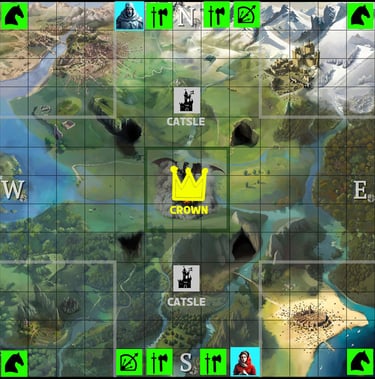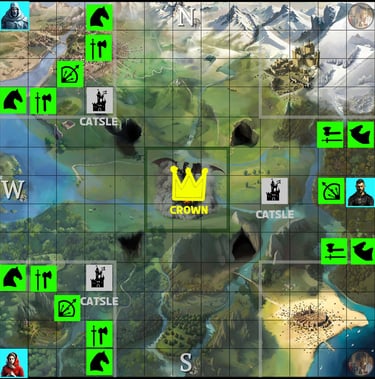Quick Match Mode
Setup
Board: The game is played on a 13x13 grid.
Pieces: Each player starts with the following pieces:
2 Cavalry
2 Infantry
1 Hero
1 Archer
1 Castle
Initial Placement:
Cavalry: Place the Cavalry units in opposite corners of the board.
Infantry: Position the Infantry units one square left and one square right of the center square in the last row on the player's side.
Hero and Archer: Place the Hero and Archer two squares apart from each other, facing each other, on the last row on the player's side.
Castle: The Castle is placed four squares from the center on the last row in the middle of the player's side.
Miniature Placement Guide for Quick Match Mode
Here is the miniature placement guide for Quick Match Mode based on the number of players. Please refer to the instructions below for proper setup.






2 Players
3 Players
4 Players
Movement and Turns
Hero: Can move three spaces up, down, left, or right per turn.
Cavalry: Can move horizontally or vertically any number of spaces.
Infantry and Archer: Can move up to 5 squares orthogonally.
Castle: Does not move.
Turn Structure: Players take turns moving one piece at a time. If a player chooses not to move a piece, they may draw a new Army Card and replace an existing one instead. Additional Army Cards cannot be added.
Castle Attack
Invulnerability: If no player possesses the Crown, all Castles are invulnerable.
Destruction Condition: If a player holds the Crown, they can destroy any opponent's Castle. Once a Castle is destroyed, that player immediately loses the game.
Card Distribution Rules
Initial Card Distribution
Hero : The main character card 1 and 2 Infantry Army Cards
Castle : Castle Card 1 and 2 infantry army cards
Ranged Units:
1 Ranged Commander Card
2 Ranged Army Cards
Infantry Units:
2 Infantry Commander Cards
4 Infantry Army Cards
Cavalry Units:
2 Cavalry Commander Cards
4 Cavalry Army Cards
Card Placement
In Akhedena Quick Match Mode, players can place two Army Cards on each Hero Card and Commander Card. The placement rules are as follows:
Hero Card
Army Type Compatibility: A Hero Card can have any Army Card placed on it, as long as the Army Card's main type matches.
Ranged Attack: If a Ranged Army Card is placed on a Hero Card, the Hero can perform ranged attacks.
Weapon Type Match: If the weapon type of the Army Card matches the weapon type of the Hero Card, the Hero's stats are applied in battle.
Flag Placement: A Mini Army Flag Card must be inserted into the back of the Hero miniature.
Commander Card
Type Icon Match: A Commander Card must match the main type icon engraved on the back of the miniature.
Army Type Compatibility: The Army Card placed on a Commander Card must have the same main type as the Commander Card.
Weapon Type Match: Both the Commander Card and the Army Card must have matching weapon types for the Commander's stats to apply.
Flag Placement: A Mini Army Flag Card must be inserted into the back of the Commander miniature, and the flag number should correspond to the card holder number.
Battle Rules
Melee Combat
Initiating Combat: When approaching an opponent’s miniature on an adjacent square, melee combat begins. The player who moves first becomes the attacker.
Attack Power: The total attack power is the combined sum of 1 Commander Card and 2 Army Cards. If the weapon types differ, the Commander’s stats are excluded.
Defense Power: Similarly, the total defense power is the combined sum of 1 Commander Card and 2 Army Cards. If the weapon types differ, the Commander’s stats are excluded.
Combat Resolution: If the attacker’s value is higher, the defender is removed. If the values are equal or the defender’s value is higher, the defender successfully defends and counterattacks.
Counterattack: If the attacker fails, the defender counterattacks with the total attack power of 1 Commander Card and 2 Army Cards. The same rules apply regarding weapon type matching.
Defender’s Counterattack Resolution: If the defender's counterattack is successful (higher attack value), the attacker’s miniature and cards are removed. If the values are equal, the result is a draw, and the turn ends.
Ranged Combat
Archer’s Range: Archers can attack any unit within a 2-square range in any direction (up, down, left, or right).
Initiating Combat: The player who moves first becomes the attacker.
Attack Power: The total attack power is the combined sum of 1 Commander Card and 2 Army Cards. If the weapon types differ, the Commander’s stats are excluded.
Defense by Infantry or Cavalry:
Each Army Card defends individually against the total attack power, regardless of weapon type.
If the defense power of a single Army Card is lower than the attacker’s combined power, that Army Card is removed. If it’s equal or higher, the defense is successful.
Infantry and Cavalry cannot counterattack. The attacker’s turn then ends.
Defense by Ranged Units:
Similar defense mechanics apply, but if the ranged defender successfully defends with remaining cards, they counterattack in the same way.
After the counterattack, the attacker’s turn ends.
The Crown
Crown Acquisition: A player can acquire the crown by moving their piece to an adjacent square where the crown is located.
Crown Benefits: The player who holds the crown can replace two Army Cards during their turn.
Crown Placement: The crown must be placed on the player's own castle.
Advantages and Disadvantages:
If a player possesses the crown, any castle can be destroyed.
If a player's castle is destroyed, they immediately lose the game.
Victory Conditions
A player wins by either:
Destroying the opponent's castle first, or
Defeating the opponent's hero first.
